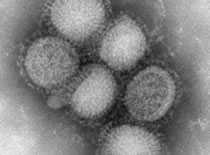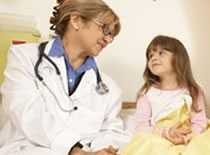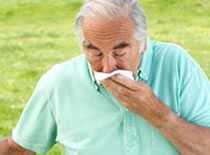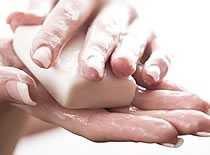Content on this page was developed during the 2009-2010 H1N1 pandemic and has not been updated.
- The H1N1 virus that caused that pandemic is now a regular human flu virus and continues to circulate seasonally worldwide.
- The English language content on this website is being archived for historic and reference purposes only.
- For current, updated information on seasonal flu, including information about H1N1, see the CDC Seasonal Flu website.
Questions & Answers
2009 H1N1 Flu ("Swine Flu") and You
February 10, 2010 5:00 PM ET
2009 H1N1 Flu
What is 2009 H1N1 (swine flu)?
2009 H1N1 (sometimes called “swine flu”) is a new influenza virus causing illness in people. This new virus was first detected in people in the United States in April 2009. This virus is spreading from person-to-person worldwide, probably in much the same way that regular seasonal influenza viruses spread. On June 11, 2009, the World Health Organization (WHO) declared that a pandemic of 2009 H1N1 flu was underway.
 Why is the 2009 H1N1 virus sometimes called “swine flu”?
Why is the 2009 H1N1 virus sometimes called “swine flu”?
This virus was originally referred to as “swine flu” because laboratory testing showed that many of the genes in the virus were very similar to influenza viruses that normally occur in pigs (swine) in North America. But further study has shown that the 2009 H1N1 is very different from what normally circulates in North American pigs. It has two genes from flu viruses that normally circulate in pigs in Europe and Asia and bird (avian) genes and human genes. Scientists call this a "quadruple reassortant" virus.
2009 H1N1 Flu in Humans
Are there human infections with 2009 H1N1 virus in the U.S.?
Yes. While 2009 H1N1 activity declined after later October, 2009 human illness with 2009 H1N1 is ongoing in the United States. In fact, the 2009 H1N1 virus is the predominant influenza virus in circulation so far during the 2009-2010 flu season. The United States experienced its first wave of 2009 H1N1 activity in the spring of 2009, followed by a second wave in the fall, with the number of people infected peaking at the end of October. There are still uncertainties surrounding the rest of this flu season, including the possibility that seasonal influenza viruses will spread during the winter as they usually do while 2009 H1N1 viruses continue to cause illness. In past pandemics, flu activity has occurred in waves and it’s possible that the United States could experience another wave either later in the 2010 winter, or later. In the past, when new viruses have emerged to cause flu pandemics, the new virus has continued to spread among people. Experts believe it’s likely that the new 2009 H1N1 virus will continue to circulate among people for some time, perhaps as a typical winter flu. In fact, a 2009 H1N1 virus has been selected as the H1N1 vaccine component for the Southern Hemisphere’s upcoming seasonal flu vaccine. (More information about the selection of the viruses for the 2010-2011 Northern Hemisphere flu vaccine is available.).
CDC routinely works with states to collect, compile and analyze information about influenza, and has done the same for the 2009 H1N1 virus since the beginning of the outbreak. This information is presented in a weekly report, called FluView.
Is the 2009 H1N1 virus contagious?
The 2009 H1N1 virus is contagious and is spreading from human to human.
How does the 2009 H1N1 virus spread?
Spread of the 2009 H1N1 virus is thought to occur in the same way that seasonal flu spreads. Flu viruses are spread mainly from person to person through coughing, sneezing or talking by people with influenza. Sometimes people may become infected by touching something – such as a surface or object – with flu viruses on it and then touching their mouth or nose.
Can I get 2009 H1N1 more than once?
February 10, 2010Getting infected with any influenza virus, including 2009 H1N1, should cause your body to develop immune resistance to that virus so it's not likely that a person would be infected with the identical influenza virus more than once. (However, people with weakened immune systems might not develop full immunity after infection and might be more likely to get infected with the same influenza virus more than once.) However, it's also possible that a person could have a positive test result for flu infection more than once in an influenza season. This can occur for two reasons:
- A person may be infected with different influenza viruses (for example, the first time with 2009 H1N1 and the second time with a regular seasonal flu virus. Most rapid tests cannot distinguish which influenza virus is responsible for the illness. And,
- Influenza tests can occasionally give false positive and false negative results so it's possible that one of the test results were incorrect. This is more likely to happen when the diagnosis is made with the rapid flu tests. More information about flu diagnosis is available.

What are the signs and symptoms of this virus in people?
The symptoms of 2009 H1N1 flu virus in people include fever, cough, sore throat, runny or stuffy nose, body aches, headache, chills and fatigue. Some people may have vomiting and diarrhea. People may be infected with the flu, including 2009 H1N1 and have respiratory symptoms without a fever. Severe illnesses and deaths have occurred as a result of illness associated with this virus.
How severe is illness associated with 2009 H1N1 flu virus?
Illness with 2009 H1N1 virus has ranged from mild to severe. While most people who have been sick have recovered without needing medical treatment, hospitalizations and deaths from infection with this virus have occurred.
In seasonal flu, certain people are at “high risk” of serious complications. This includes people 65 years and older, children younger than five years old, pregnant women, and people of any age with certain chronic medical conditions. More than 70 percent of adults who have been hospitalized with the 2009 H1N1 virus have had one or more medical conditions previously recognized as placing people at “higher risk” of serious seasonal flu-related complications. This includes pregnancy, diabetes, heart disease, asthma and kidney disease. In one study, fifty-seven percent of children who had been hospitalized as a result of 2009 H1N1 have had one or more “higher risk” medical conditions.
Young children are also at high risk of serious complications from 2009 H1N1, just as they are from seasonal flu. And while people 65 and older are less likely to be infected with 2009 H1N1 flu, if they get sick, they are also at “high risk” of developing serious complications from their illness.
CDC laboratory studies have shown that no children and very few adults younger than 60 years old have existing antibody to the 2009 H1N1 flu virus; however, about one-third of adults older than 60 may have antibodies against this virus. It is unknown how much, if any, protection may be afforded against 2009 H1N1 flu by any existing antibody.
Who is at higher risk from serious 2009 H1N1 related complications?
Most people who get the flu (either seasonal or 2009 H1N1) will have mild illness, will not need medical care or antiviral drugs, and will recover in less than two weeks. Some people, however, are more likely to get flu complications that result in being hospitalized and occasionally result in death. Pneumonia, bronchitis, sinus infections and ear infections are examples of flu-related complications. The flu can also make chronic health problems worse. For example, people with asthma may experience asthma attacks while they have the flu, and people with chronic congestive heart failure may have worsening of this condition that is triggered by the flu. The list below includes the groups of people more likely to get flu-related complications if they get sick from influenza.
People at High Risk for Developing Flu-Related Complications
- Children younger than 5, but especially children younger than 2 years old
- Adults 65 years of age and older
- Pregnant women
People who have medical conditions including:
- Asthma
- Neurological and neurodevelopmental conditions [including disorders of the brain, spinal cord, peripheral nerve, and muscle such as cerebral palsy, epilepsy (seizure disorders), stroke, intellectual disability (mental retardation), moderate to severe developmental delay, muscular dystrophy, or spinal cord injury].
- Chronic lung disease (such as chronic obstructive pulmonary disease [COPD] and cystic fibrosis)
- Heart disease (such as congenital heart disease, congestive heart failure and coronary artery disease)
- Blood disorders (such as sickle cell disease)
- Endocrine disorders (such as diabetes mellitus)
- Kidney disorders
- Liver disorders
- Metabolic disorders (such as inherited metabolic disorders and mitochondrial disorders)
- Weakened immune system due to disease or medication (such as people with HIV or AIDS, or cancer, or those on chronic steroids)
- People younger than 19 years of age who are receiving long-term aspirin therapy
How does 2009 H1N1 flu compare to seasonal flu in terms of its severity and infection rates?
Flu seasons vary in terms of timing, duration and severity. Seasonal influenza can cause mild to severe illness, and at times can lead to death. Each year, in the United States, on average 36,000 people die from flu-related complications and more than 200,000 people are hospitalized from flu-related causes. Of those hospitalized, 20,000 are children younger than 5 years old. More than 90% of deaths and about 60 percent of hospitalization occur in people older than 65.
CDC estimates of the numbers of 2009 H1N1 cases, hospitalizations and deaths are that people younger than 65 years of age are more severely affected by 2009 H1N1 flu relative to people 65 and older compared with seasonal flu. CDC estimates that with 2009 H1N1, approximately 90% of hospitalizations and 88% of estimated deaths from April through December 12, 2009 occurred in people younger than 65 years old. However, because severe illness and deaths have occurred among people 65 and older and because supplies of 2009 H1N1 vaccine have increased dramatically, CDC is now encouraging all people 6 months and older, including people older than 65, to get vaccinated against 2009 H1N1.
How long can an infected person spread this virus to others?
People infected with seasonal and 2009 H1N1 flu shed virus and may be able to infect others from 1 day before getting sick to 5 to 7 days after. This can be longer in some people, especially children and people with weakened immune systems and in people infected with 2009 H1N1 viruses.
Prevention & Treatment
I Never Get the Flu (Public Service Announcement)
 If you think 2009 H1N1 flu can’t affect you, your family, or your friends—think again. Take 60 seconds to watch this reminder on why vaccination is so important. All of the excuses any of us make don’t stand a chance against this serious disease.
If you think 2009 H1N1 flu can’t affect you, your family, or your friends—think again. Take 60 seconds to watch this reminder on why vaccination is so important. All of the excuses any of us make don’t stand a chance against this serious disease.
Influenza Round Table: Take 3 Video
 Dr. Joe Bresee describes how to keep from getting the flu, and spreading it to others by taking these three steps.
Dr. Joe Bresee describes how to keep from getting the flu, and spreading it to others by taking these three steps.
What can I do to protect myself from getting sick?
This season, there is a seasonal flu vaccine to protect against seasonal flu viruses and a 2009 H1N1 vaccine to protect against the 2009 H1N1 influenza virus (sometimes called “swine flu”). A flu vaccine is by far the most important step in protecting against flu infection. For information about the 2009 H1N1 vaccines, visit H1N1 Flu Vaccination Resources. For information about seasonal influenza vaccines, visit Preventing Seasonal Flu With Vaccination.
There are also everyday actions that can help prevent the spread of germs that cause respiratory illnesses like the flu.
Take these everyday steps to protect your health:
Cover your nose and mouth with a tissue when you cough or sneeze. Throw the tissue in the trash after you use it.
- Wash your hands often with soap and water. If soap and water are not available, use an alcohol-based hand rub.*
- Avoid touching your eyes, nose or mouth. Germs spread this way.
- Try to avoid close contact with sick people.
- If you are sick with flu-like illness, CDC recommends that you stay home for at least 24 hours after your fever is gone except to get medical care or for other necessities. (Your fever should be gone without the use of a fever-reducing medicine.*) Keep away from others as much as possible to keep from making others sick.
Other important actions that you can take are:
- Follow public health advice regarding school closures, avoiding crowds and other social distancing measures.
- Be prepared in case you get sick and need to stay home for a week or so; a supply of over-the-counter medicines, alcohol-based hand rubs * (for when soap and water are not available), tissues and other related items could help you to avoid the need to make trips out in public while you are sick and contagious.
 What is the best way to keep from spreading the virus through coughing or sneezing?
What is the best way to keep from spreading the virus through coughing or sneezing?
If you are sick with flu-like illness, CDC recommends that you stay home for at least 24 hours after your fever is gone except to get medical care or for other necessities. (Your fever should be gone without the use of a fever-reducing medicine.*)
Keep away from others as much as possible. Cover your mouth and nose with a tissue when coughing or sneezing. Put your used tissue in the waste basket. Then, clean your hands, and do so every time you cough or sneeze.
If I have a family member at home who is sick with 2009 H1N1 flu, should I go to work?
Employees who are well but who have an ill family member at home with 2009 H1N1 flu can go to work as usual. These employees should monitor their health every day, and take everyday precautions including covering their coughs and sneezes and washing their hands often with soap and water, especially after they cough or sneeze. If soap and water are not available, they should use an alcohol-based hand rub.* If they become ill, they should notify their supervisor and stay home. Employees who have an underlying medical condition or who are pregnant should call their health care provider for advice, because they might need to receive influenza antiviral drugs. For more information please see General Business and Workplace Guidance for the Prevention of Novel Influenza A (H1N1) Flu in Workers.
What is the best technique for washing my hands to avoid getting the flu?
Washing your hands often will help protect you from germs. CDC recommends that when you wash your hands -- with soap and warm water -- that you wash for 15 to 20 seconds. When soap and water are not available, alcohol-based disposable hand wipes or gel sanitizers may be used.* You can find them in most supermarkets and drugstores. If using gel, rub your hands until the gel is dry. The gel doesn't need water to work; the alcohol in it kills the germs on your hands.
What should I do if I get sick?
For information about what to do if you get sick with flu-like symptoms this season, see What To Do If You Get Sick: 2009 H1N1 and Seasonal Flu. A downloadable flyer containing this information also is available.
What should I do if I have a fever?
Fever can be one of the symptoms of a flu-like illness for many people. A fever is an oral temperature of at least 100 degrees Fahrenheit (37.8 degrees Celsius). Signs of a fever include chills, a flushed appearance, feeling very warm, or sweating.
Fever-reducing medicines typically contain acetaminophen (such as Tylenol) or ibuprofen (such as Motrin). These medicines can both help bring fever down and relieve pain. Aspirin (acetylsalicylic acid) should not be given to children or teenagers (anyone aged 18 years and younger) who have flu; this can cause a rare but serious illness called Reye’s syndrome.
To help avoid spreading the flu, if you have a fever, stay at home for at least 24 hours after you no longer have a fever or signs of a fever. However, if you're taking fever-reducing medicines, you cannot tell if your fever is truly gone. Therefore, when you start to feel better, increase the interval between doses of fever-reducing medicines and continue to monitor your temperature to make sure your fever does not return.
What are “emergency warning signs” that should signal anyone to seek medical care urgently?
Influenza Round Table: Warning Signs Video
 Dr. Joe Bresee describes the main symptoms of flu, including 2009 H1N1 flu, and when it is serious enough to seek medical help.
Dr. Joe Bresee describes the main symptoms of flu, including 2009 H1N1 flu, and when it is serious enough to seek medical help.
In children:
- Fast breathing or trouble breathing
- Bluish skin color
- Not drinking enough fluids
- Not waking up or not interacting
- Being so irritable that the child does not want to be held
- Flu-like symptoms improve but then return with fever and worse cough
- Fever with a rash
In adults:
- Difficulty breathing or shortness of breath
- Pain or pressure in the chest or abdomen
- Sudden dizziness
- Confusion
- Severe or persistent vomiting
- Flu-like symptoms that improve but then return with fever and worse cough
Are there medicines to treat 2009 H1N1 infection?
Influenza Round Table: Antiviral Drugs Video
 Influenza Round Table: Antiviral Drugs
Dr. Joe Bresee explains the nature of antiviral drugs and how they are used.
Influenza Round Table: Antiviral Drugs
Dr. Joe Bresee explains the nature of antiviral drugs and how they are used.
What is CDC’s recommendation regarding "swine flu parties"?
"Swine flu parties" are gatherings during which people have close contact with a person who has 2009 H1N1 flu in order to become infected with the virus. The intent of these parties is for a person to become infected with what for many people has been a mild disease, in the hope of having natural immunity 2009 H1N1 flu virus that might circulate later and cause more severe disease.
CDC does not recommend "swine flu parties" as a way to protect against 2009 H1N1 flu in the future. While the disease seen in the current 2009 H1N1 flu outbreak has been mild for many people, it has been severe and even fatal for others. There is no way to predict with certainty what the outcome will be for an individual or, equally important, for others to whom the intentionally infected person may spread the virus. Vaccination against 2009 H1N1 with a 2009 H1N1 vaccine is the best way to protect against this virus. Supplies of 2009 H1N1 vaccine are ample and CDC is now recommending that everyone get vaccinated.
CDC recommends that people with 2009 H1N1 flu avoid contact with others as much as possible. If you are sick with flu-like illness, CDC recommends that you stay home for at least 24 hours after your fever is gone except to get medical care or for other necessities. (Your fever should be gone without the use of a fever-reducing medicine.*) Stay away from others as much as possible to keep from making others sick.
Contamination & Cleaning
 How long can influenza virus remain viable on objects (such as books and doorknobs)?
How long can influenza virus remain viable on objects (such as books and doorknobs)?
Studies have shown that influenza virus can survive on environmental surfaces and can infect a person for 2 to 8 hours after being deposited on the surface.
What kills influenza virus?
Influenza virus is destroyed by heat (167-212°F [75-100°C]). In addition, several chemical germicides, including chlorine, hydrogen peroxide, detergents (soap), iodophors (iodine-based antiseptics), and alcohols are effective against human influenza viruses if used in proper concentration for a sufficient length of time.
*What if soap and water are not available and alcohol-based products are not allowed in my facility?
If soap and water are not available and alcohol-based products are not allowed, other hand sanitizers that do not contain alcohol may be useful.
What surfaces are most likely to be sources of contamination?
Germs can be spread when a person touches something that is contaminated with germs and then touches his or her eyes, nose, or mouth. Droplets from a cough or sneeze of an infected person move through the air. Germs can be spread when a person touches respiratory droplets from another person on a surface like a desk, for example, and then touches their own eyes, mouth or nose before washing their hands.
How should waste disposal be handled to prevent the spread of influenza virus?
To prevent the spread of influenza virus, it is recommended that tissues and other disposable items used by an infected person be thrown in the trash. Additionally, persons should wash their hands with soap and water after touching used tissues and similar waste.
 What household cleaning should be done to prevent the spread of influenza virus?
What household cleaning should be done to prevent the spread of influenza virus?
To prevent the spread of influenza virus it is important to keep surfaces (especially bedside tables, surfaces in the bathroom, kitchen counters and toys for children) clean by wiping them down with a household disinfectant according to directions on the product label.
How should linens, eating utensils and dishes of persons infected with influenza virus be handled?
Linens, eating utensils, and dishes belonging to those who are sick do not need to be cleaned separately, but importantly these items should not be shared without washing thoroughly first.
Linens (such as bed sheets and towels) should be washed by using household laundry soap and tumbled dry on a hot setting. Individuals should avoid "hugging" laundry prior to washing it to prevent contaminating themselves. Individuals should wash their hands with soap and water or alcohol-based hand rub immediately after handling dirty laundry.
Eating utensils should be washed either in a dishwasher or by hand with water and soap.
Exposures Not Thought to Spread 2009 H1N1 Flu
Can I get infected with 2009 H1N1 virus from eating or preparing pork?
No. 2009 H1N1 viruses are not spread by food. You cannot get infected with 2009 HIN1 from eating pork or pork products. Eating properly handled and cooked pork products is safe.
Is there a risk from drinking water?
Tap water that has been treated by conventional disinfection processes does not likely pose a risk for transmission of influenza viruses. Current drinking water treatment regulations provide a high degree of protection from viruses. No research has been completed on the susceptibility of 2009 H1N1 flu virus to conventional drinking water treatment processes. However, recent studies have demonstrated that free chlorine levels typically used in drinking water treatment are adequate to inactivate highly pathogenic H5N1 avian influenza. It is likely that other influenza viruses such as 2009 H1N1 would also be similarly inactivated by chlorination. To date, there have been no documented human cases of influenza caused by exposure to influenza-contaminated drinking water.
Can 2009 H1N1 flu virus be spread through water in swimming pools, spas, water parks, interactive fountains, and other treated recreational water venues?
Influenza viruses infect the human upper respiratory tract. There has never been a documented case of influenza virus infection associated with water exposure. Recreational water that has been treated at CDC recommended disinfectant levels does not likely pose a risk for transmission of influenza viruses. No research has been completed on the susceptibility of 2009 H1N1 influenza virus to chlorine and other disinfectants used in swimming pools, spas, water parks, interactive fountains, and other treated recreational venues. However, recent studies have demonstrated that free chlorine levels recommended by CDC (1–3 parts per million [ppm or mg/L] for pools and 2–5 ppm for spas) are adequate to disinfect avian influenza A (H5N1) virus. It is likely that other influenza viruses such as 2009 H1N1 virus would also be similarly disinfected by chlorine.
Can 2009 H1N1 influenza virus be spread at recreational water venues outside of the water?
Yes, recreational water venues are no different than any other group setting. The spread of this 2009 H1N1 flu is thought to be happening in the same way that seasonal flu spreads. Flu viruses are spread mainly from person to person through coughing or sneezing of people with influenza. Sometimes people may become infected by touching something with flu viruses on it and then touching their mouth or nose.
2009 H1N1 in Pets
What animals can be infected with the 2009 H1N1 virus?
In addition to humans, live swine and turkeys, a small number of ferrets (which are highly susceptible to influenza A viruses), domestic cats and dogs have been infected with 2009 H1N1 virus. In addition, 2009 H1N1 virus infection was reported in a cheetah in the United States. CDC is working closely with domestic and international public and animal health partners to continually monitor reports of 2009 H1N1 in animals and will provide additional information to the public as it becomes available.
How do pets become infected with 2009 H1N1?
All available information suggests that the ferrets and domestic cats infected with 2009 H1N1 infections acquired the virus through close contact with ill humans.Can I get 2009 H1N1 influenza from my pet?
Available evidence suggests that transmission has been from ill humans to their companion animals. No evidence is available to suggest that animals are infecting humans with 2009 H1N1 virus.What do I do if I am sick with flu-like symptoms and I have pets?
If you are sick with influenza-like-illness, take the same precautions with your pets that you would to keep your family and friends healthy:- Cover your coughs and sneezes
- Wash your hands frequently
- Minimize contact with your pets until 24 hours after your fever is gone without the use of fever reducing medication
What should I do if I suspect my pet has 2009 H1N1 influenza virus?
If members of your household have flu-like symptoms, and your pet exhibits respiratory illness, contact your veterinarian.Is there a vaccine available for my pet?
Currently, there is not a licensed and approved 2009 H1N1 vaccine for pets. (There is a canine influenza vaccine, which protects dogs from the H3N8 canine flu virus, but it will not protect pets against the 2009 H1N1 virus, and the H3N8 vaccine should not be used in any species other than dogs.)How serious is this disease in pets?
Pet ferrets with naturally occurring 2009 H1N1 infection have exhibited illness similar in severity to that seen in ferrets exposed to seasonal influenza viruses and to 2009 H1N1 virus in laboratory settings. Clinical signs exhibited have included sneezing, inactivity, and weight loss. Of the reported cases, most of the pets have recovered fully with supportive care, although some have died.
Get email updates
To receive weekly email updates about this site, enter your email address:
Contact Us:
- Centers for Disease Control and Prevention
1600 Clifton Rd
Atlanta, GA 30333 - 800-CDC-INFO
(800-232-4636)
TTY: (888) 232-6348 - Contact CDC-INFO


